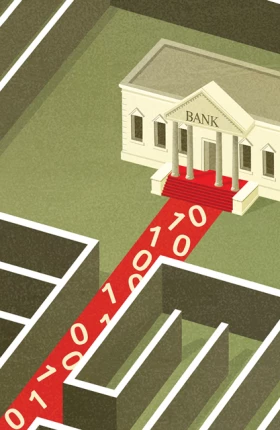In a previous article, The Boston Consulting Group argued that, for retail banks, a focus on customer-centricity—defined as a way of operating “based on trust and fairness that uses knowledge of customers to meet their needs and achieve sustainable, valuable, long-term relationships”—is becoming an increasingly important differentiator in the
Rapidly evolving digital capabilities—particularly mobile, social-media, big-data, and cloud technologies—offer financial services companies entirely new opportunities for understanding, serving, and engaging customers. These capabilities will be powerful allies in the pursuit of greater customer-centricity. Many companies recognize this but—given the range of possibilities and the speed with which the technology is advancing—are uncertain about how to proceed. Yet time to think things through fully and at an unhurried pace is a luxury that many businesses might not have. Customers’ expectations regarding what is possible in today’s digital landscape continue to rise—as does the ease with which a customer can identify a competitor that outdelivers and move his or her business.
Whether by carrot, stick, or a combination of the two, then, most financial-services companies will be propelled further into the digital space as they strive for greater customer-centricity. Our advice: be bold and proactive—even if it means making mistakes. For those that move quickly, there is high potential for sizable early-mover advantages. Indeed, a handful of companies are already pushing the envelope aggressively on this front and reaping rewards.
The Digital Edge
Today’s evolving digital capabilities can help financial services companies achieve greater customer-centricity by breaking some of the key compromises the industry has had to wrestle with historically. In the past, the form, frequency, and caliber of companies’ interactions with customers have been governed to a great extent by operational limitations. Legacy systems and back-office restrictions (for example, independent computer systems and data centers that are siloed by business line) have curtailed companies’ options regarding product design and delivery, targeting, communications, and service levels in general. The notion of being able to serve customers when, where, and how they want to be served, with products that meet their specific needs, has remained more a vision than reality.
But available digital capabilities can change the
To get a sense of the possibilities, consider a highly popular service that many banks already offer customers: ATM locator maps that can be accessed with a mobile phone. In the not-too-distant past, getting such information (literally) into customers’ hands would have been highly difficult, to say the least. Now, however, it is relatively straightforward. And, critically, the bank, by “mashing up” digitally enabled capabilities made available by others—such as mobile data access through the mobile-phone-service provider, a software delivery ecosystem through an app store, GPS technology included in the smartphone, and the digital map provided by a third-party Web service—can deliver this service without having to make its own material investment. All the bank has to do is provide its ATM-location data and create the app that serves as the conduit for the desired customer experience.
Tomorrow’s champions of customer-centricity will, no doubt, actively exploit the possibilities that this new reality affords. What suite of capabilities will tomorrow’s state-of-the-art, digitally enabled players possess and deploy? The following scenario is based on trends we have observed in our client work. Companies will utilize a big-data approach to understand direct and indirect communications and feedback from customers and prospects, including communications and feedback received through social media. They will use that information, coupled with hypothesis-driven analytics, to develop and tailor personalized products, services, delivery methods, and communications.
Companies will combine these with the capture and study of every transaction and touch point they share with customers through customer-relationship-management software to determine how they can improve the caliber of their interactions. They will model and test new products regularly, creatively, and efficiently—in specific regions, among specific customer cohorts, and for specific time periods—to glean new insights, employing a “fail fast, fail often” philosophy. They will present customers with a truly user-friendly and unified experience that is consistent across channels. The result will be greater customer satisfaction—coupled with a lower cost-to-income ratio.
A Current Exemplar: USAA
USAA is a leader in digitally enabled customer-centricity in the financial services sector. The Texas-based diversified financial-services player, whose products and services include banking, property and casualty insurance, credit cards, financial planning, and car-buying advice, caters to individuals (and their families) who currently serve or have served in the U.S. military. Its membership exceeds 8 million.
The company is renowned for its focus on and deep relationships with customers. Its Net Promoter Score, for example—a widely recognized measure of customer loyalty—is consistently superior to the scores of its competitors: the company’s 2012 score of 83 percent stands well above the industry
Digitization also underpinned the creation of the company’s unique member-experience initiative, which supports the strategy by integrating USAA’s various lines of business into a single unified organization. (See “USAA’s Wayne Peacock on Customer-Centricity,” below.) And digitization, particularly the opportunities afforded by today’s technologies, remains a vital part of USAA’s ongoing efforts to improve and expand the customer experience. USAA customers can now, for example, use their mobile phones to pay their bills with text messaging, trade stocks with a mobile app, and change their ATM and debit-card personal-identification numbers.
USAA's Wayne Peacock on Customer-Centricity
Wayne Peacock is the executive vice president, member experience, at USAA. He oversees the company’s marketing, channel management, sales, and service functions. He recently spoke with Jeanne Ross (director) and Martin Mocker (research scientist) of the Center for Information Systems Research at the MIT Sloan School of Management about USAA’s focus on the customer. Below are excerpts from the discussion.
How has digitization enabled USAA’s transition to a customer-centric model?
Its main contribution is that it has afforded us a single, unified view of the customer. Whether a customer is doing business with a USAA property and casualty company or the bank, or has purchased product A, B, or C, he or she has a unique identifier that transcends all of the individual operations at USAA. This has given us a huge leg up in our ability to be customer-centric.
What is USAA’s ultimate aim regarding customer-centricity?
We truly aspire to become our members’ trusted advisor, to be there every day and at those important times when our advice can help them achieve financial security.
Have the company’s efforts toward customer-centricity been reflected in your client-based metrics?
Yes. Our efforts have paid us huge rewards, particularly in member loyalty, member retention, and member advocacy.
Has having a dedicated organization focused on the customer experience enhanced the company’s efforts toward customer-centricity?
Yes. This is about serving members in a holistic way and over their entire lifetime. We recognized that to do that really well, we needed to get the company organized around members and their needs rather than around product silos or regulated lines of business. The creation of our member-experience division essentially did that. It integrated our frontline teams and call-center staff in a way that better serves members and better meets their needs by reducing the number of handoffs from one agent to the next. We then tied this into our digital channels and marketing function, because we saw that what our members were going through in life often required solutions that spanned our product silos and distribution channels. If we were organized the way we were in the past, members would be forced to jump across those silos, making for a completely different experience.
What have been the key factors that have allowed USAA to successfully execute an integrated strategy centered on members’ life events?
First, we have a passion for serving members. Second, we have a leadership team that is calibrated around one “North Star,” which is USAA’s mission to serve the military community. Third, our leadership team’s close physical proximity means that we’re able to come together and talk about things face-to-face and understand both the qualitative and quantitative issues around tradeoffs. And we’re getting better and better at doing that. In fact, the level of leadership alignment is probably the most powerful factor behind our success.
The company’s customer-centricity has been enabled by many other capabilities built over the years. Technology-driven efforts, including the early creation of a single file for each customer, the use of common frameworks and integrated middleware, adherence to principles of good engineering, and the integration of business and IT, have been critical. But actions on the cultural front, including strong commitment from leadership, a clear mission statement, an understanding that this would be a long-term effort, regular communication, and well-considered job training and rotation, have also been important. Organizational moves—for example, the creation of connect-the-dots functions, forums for the discussion of integration challenges, and the institution of metrics and a rewards system—have also played roles.
Getting Started
Although digital capabilities are the linchpin, they are not, by themselves, sufficient for achieving meaningful levels of customer-centricity, as USAA’s example illustrates. True customer-centricity also demands significant changes at the organizational level, including changes in governance—for example, organizing around the customer rather than the product or channel. And it necessitates overhauling the company’s culture to ensure that a paramount focus on the customer’s interests becomes firmly embedded in the company’s DNA. The company must change its orientation from How can we sell more of product X, Y, or Z? to What does the customer really want, and how can we provide it?
Actively committing to greater use of digital capabilities is an essential first step toward greater customer-centricity. It can also serve as a catalyst for broader customer-centricity efforts. If your company is just starting on the journey, begin by taking a critical look at the company’s value chain and determining where digital capabilities might be deployed to support one or several of your core strategic aims. Define your precise objective: for example, We will employ digital technologies to improve our understanding of customer preferences regarding retirement-focused products, and we will use that understanding to improve our offering, customer experience, and, ultimately, our market share. Indeed, a better understanding of customers should be the primary focus for virtually any company starting down the digital path toward greater customer-centricity. Once an objective has been set, start with a pilot, leveraging your company’s internal best practices.
For most financial-services companies, achieving game-changing levels of customer-centricity through the leveraging of digital capabilities will be a multiyear journey. But there is no gain in waiting.







